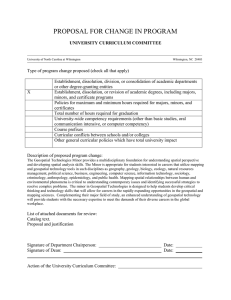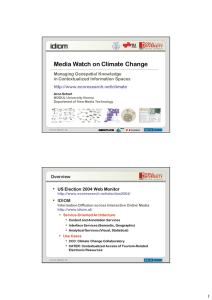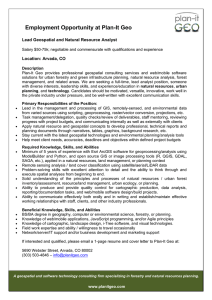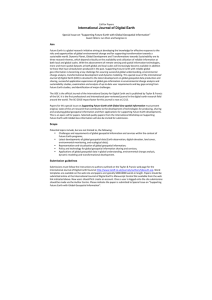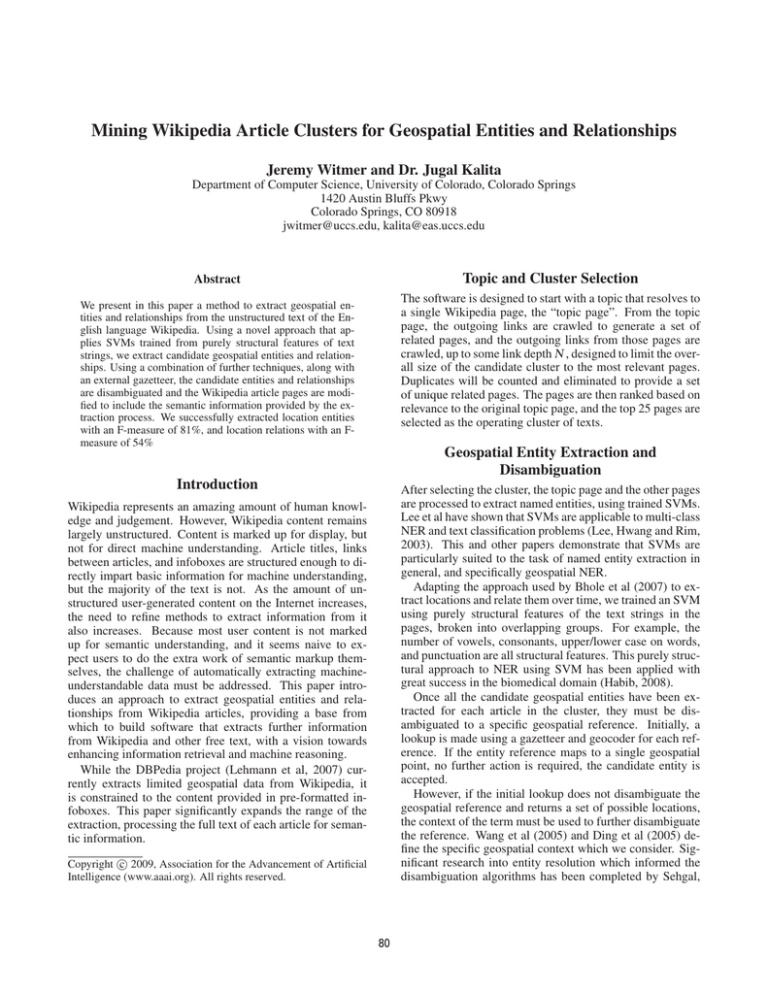
Mining Wikipedia Article Clusters for Geospatial Entities and Relationships
Jeremy Witmer and Dr. Jugal Kalita
Department of Computer Science, University of Colorado, Colorado Springs
1420 Austin Bluffs Pkwy
Colorado Springs, CO 80918
jwitmer@uccs.edu, kalita@eas.uccs.edu
Topic and Cluster Selection
Abstract
The software is designed to start with a topic that resolves to
a single Wikipedia page, the “topic page”. From the topic
page, the outgoing links are crawled to generate a set of
related pages, and the outgoing links from those pages are
crawled, up to some link depth N , designed to limit the overall size of the candidate cluster to the most relevant pages.
Duplicates will be counted and eliminated to provide a set
of unique related pages. The pages are then ranked based on
relevance to the original topic page, and the top 25 pages are
selected as the operating cluster of texts.
We present in this paper a method to extract geospatial entities and relationships from the unstructured text of the English language Wikipedia. Using a novel approach that applies SVMs trained from purely structural features of text
strings, we extract candidate geospatial entities and relationships. Using a combination of further techniques, along with
an external gazetteer, the candidate entities and relationships
are disambiguated and the Wikipedia article pages are modified to include the semantic information provided by the extraction process. We successfully extracted location entities
with an F-measure of 81%, and location relations with an Fmeasure of 54%
Geospatial Entity Extraction and
Disambiguation
Introduction
After selecting the cluster, the topic page and the other pages
are processed to extract named entities, using trained SVMs.
Lee et al have shown that SVMs are applicable to multi-class
NER and text classification problems (Lee, Hwang and Rim,
2003). This and other papers demonstrate that SVMs are
particularly suited to the task of named entity extraction in
general, and specifically geospatial NER.
Adapting the approach used by Bhole et al (2007) to extract locations and relate them over time, we trained an SVM
using purely structural features of the text strings in the
pages, broken into overlapping groups. For example, the
number of vowels, consonants, upper/lower case on words,
and punctuation are all structural features. This purely structural approach to NER using SVM has been applied with
great success in the biomedical domain (Habib, 2008).
Once all the candidate geospatial entities have been extracted for each article in the cluster, they must be disambiguated to a specific geospatial reference. Initially, a
lookup is made using a gazetteer and geocoder for each reference. If the entity reference maps to a single geospatial
point, no further action is required, the candidate entity is
accepted.
However, if the initial lookup does not disambiguate the
geospatial reference and returns a set of possible locations,
the context of the term must be used to further disambiguate
the reference. Wang et al (2005) and Ding et al (2005) define the specific geospatial context which we consider. Significant research into entity resolution which informed the
disambiguation algorithms has been completed by Sehgal,
Wikipedia represents an amazing amount of human knowledge and judgement. However, Wikipedia content remains
largely unstructured. Content is marked up for display, but
not for direct machine understanding. Article titles, links
between articles, and infoboxes are structured enough to directly impart basic information for machine understanding,
but the majority of the text is not. As the amount of unstructured user-generated content on the Internet increases,
the need to refine methods to extract information from it
also increases. Because most user content is not marked
up for semantic understanding, and it seems naive to expect users to do the extra work of semantic markup themselves, the challenge of automatically extracting machineunderstandable data must be addressed. This paper introduces an approach to extract geospatial entities and relationships from Wikipedia articles, providing a base from
which to build software that extracts further information
from Wikipedia and other free text, with a vision towards
enhancing information retrieval and machine reasoning.
While the DBPedia project (Lehmann et al, 2007) currently extracts limited geospatial data from Wikipedia, it
is constrained to the content provided in pre-formatted infoboxes. This paper significantly expands the range of the
extraction, processing the full text of each article for semantic information.
c 2009, Association for the Advancement of Artificial
Copyright Intelligence (www.aaai.org). All rights reserved.
80
Getoor and Viechnicki (2006). Additionally, because the
cluster of candidate articles are all related, geospatial information from across the cluster is used to disambiguate
individual candidate entities within single articles.
Between the gazetteer/geocoder lookup and the disambiguation algorithms, the geospatial entities are reduced to
a correct set. This geospatial data can then be used to do a
number of things:
However, as a result of other events, many belligerents entered the war before or after this date, during
a period which spanned from 1937 to 1941. Amongst
these main events are the Marco Polo Bridge Incident,
the start of Operation Barbarossa and the attack on
Pearl Harbor and British and Netherlands colonies
in South East Asia.
Conclusion
• Allow the Wikipedia article to be annotated with RDFS
that communicates geospatial semantic information.
This work focused on the extraction and disambiguation of
geospatial entities and relations. Leveraging previous work
done with SVMs for NER using structural features, and
geospatial reference disambiguation, we provide advances
in accuracy in this area leading to techniques and tools that
allow for the extraction, processing, and visualization of
geospatial attributes embedded in the unstructured text of
user-generated media. We can also annotate the existing textual information with semantic markup that communicates
semantic information and relationships.
• Annotate the link structure of the article cluster itself with
relational information to capture geospatial relationships
between the articles.
• Inform queries to Wikipedia for geospatial information.
• Allow the cluster of articles to be visualized geospatially.
all providing additional semantic information on top of
the already significant informational content of Wikipedia,
without demanding extra work from the large population of
editors who contribute to Wikipedia.
References
Bhole, A.; Fortuna, B.; Grobelnik, M.; and Mladenic, D.
2007. Extracting named entities and relating them over
time based on wikipedia. Informatica 4(4):463–468.
Ding, J.; Gravano, L.; and Shivakumar, N. 2000. Computing Geographical Scopes of Web Resources. Proceedings
of the 26th International Conference on Very Large Data
Bases 545–556.
Giuliano, C.; Lavelli, A.; and Romano, L. 2007. Relation extraction and the influence of automatic named-entity
recognition. ACM Trans. Speech Lang. Process. 5(1):1–26.
Habib, M. 2008. Improving scalability of support vector
machines for biomedical named entity recogntion. Computer Science Department, University of Colorado at Colorado Springs.
Herskovits, A. 1998. Representation and processing of
spatial expressions. Mahwah, NJ, USA: Lawrence Erlbaum Associates, Inc.
Lee, K.-J.; Hwang, Y.-S.; and Rim, H.-C. 2003. Two-phase
biomedical ne recognition based on svms. In Proceedings
of the ACL 2003 workshop on Natural language processing
in biomedicine, 33–40. Morristown, NJ, USA: Association
for Computational Linguistics.
Lehmann, J.; Schppel, J.; Auer, S.; Bizer, C.; and Becker,
C. 2008. http://dbpedia.org.
Sehgal, V.; Getoor, L.; and Viechnicki, P. D. 2006. Entity resolution in geospatial data integration. In GIS ’06:
Proceedings of the 14th annual ACM international symposium on Advances in geographic information systems, 83–
90. New York, NY, USA: ACM.
Wang, C.; Xie, X.; Wang, L.; Lu, Y.; and Ma, W. 2005.
Detecting geographic locations from web resources. Proceedings of the 2005 workshop on Geographic information
retrieval 17–24.
Geospatial Relationship Extraction
While the extraction of named entities, including locations,
is a well-researched field, research into the extraction of relations between entities is an up-and-coming field. Adapting
the work of Giuliano, Lavelli and Romano (2007) in using
NER to aid relation extraction, the geospatial relationships
are extracted using a trained SVM based on the structural
feature methods above, with the structure definition based
on the work of Herskovitz (1998) on the format of English
spatial expressions. Herskovitz has done extensive research
into locative expressions, and produced one of the seminal
works on the semantics and structure of these expressions.
Tagging the previously extracted locations as named entities, the structure of the string around the locations and expression terms is used to classify locative expressions. Once
extracted, these expressions are used to provide semantic information relating the entities in the articles.
Results
Using the methods discussed above, we have achieved an Fmeasure of 81% in extracting and disambiguating geospatial
entities. We have further achieved an F-measure of 54% in
extracting locative expressions relating the location entities.
For training, a corpus was extracted from the Reuters article
set and the locative relations and geospatial entities tagged.
A set of manually-tagged articles from Wikipedia was used
for testing.
As an example, consider the following paragraph (from
the World War II Article on Wikipedia). Candidate entities
are italic, and those disambiguated correctly by our software
are bold. Relationships found by the software are also bold.
The starting date of the war is generally held to be
September 1939 with the German invasion of Poland
and subsequent declarations of war on Germany by the
United Kingdom, France and the British Dominions.
81


